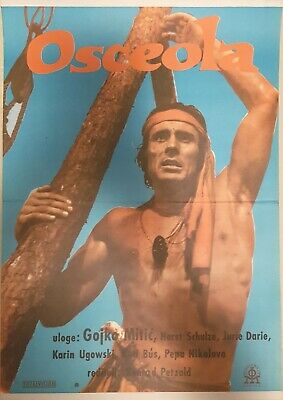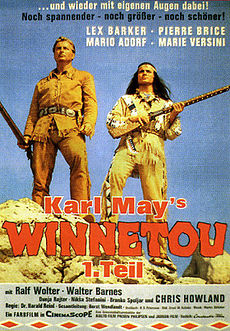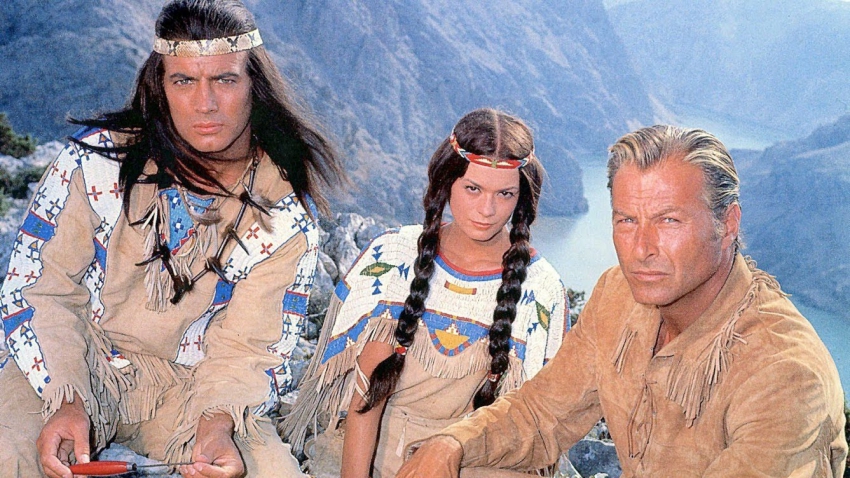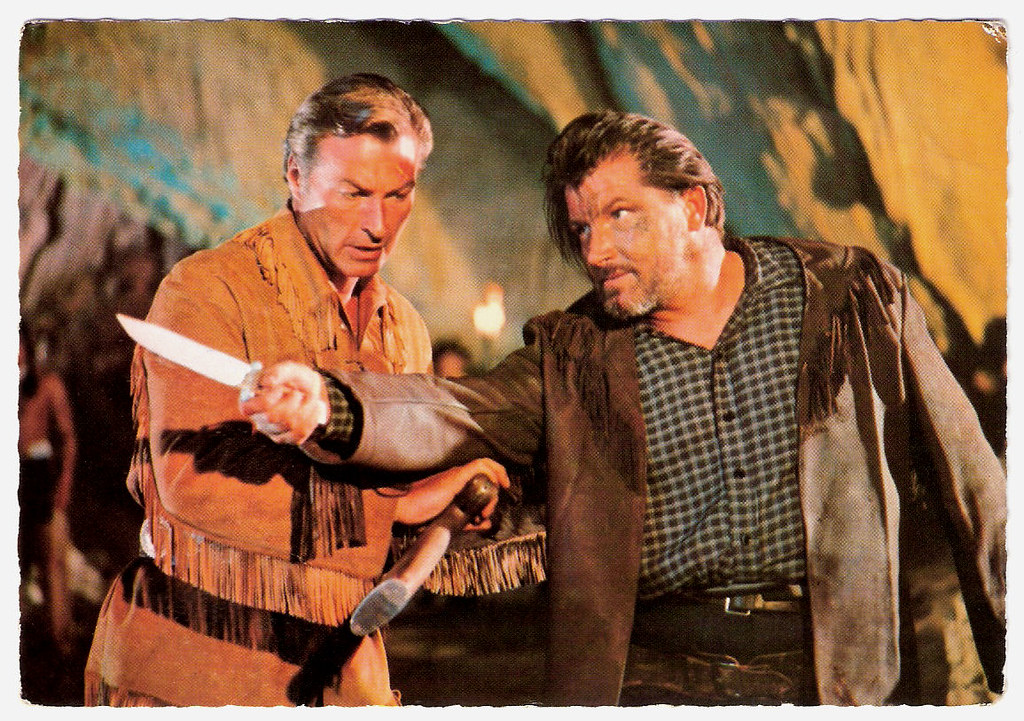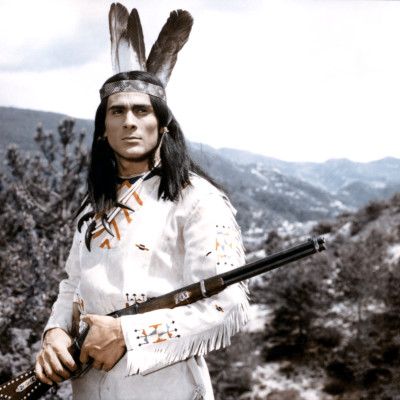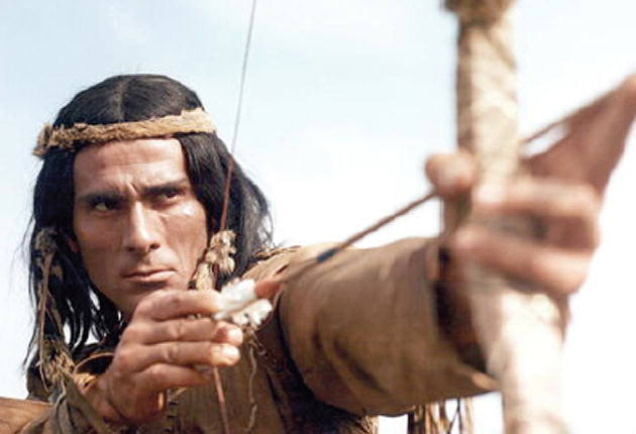Three German Westerns of
the 1960's

Winnetou (1963) - 7.0
Director: Harald Reinl
Aka - Apache Gold
It wasn't just Italy who was knocking out Westerns in the 1960's but also
Germany where the Western was very popular. Not just in West Germany but
interestingly in East Germany as well where they were termed "Indianerfilms"
in which the Indians were the good guys fighting American capitalism, racism
and imperialism. I wonder if any of those are available? This German fascination
for Westerns can be traced back to a writer in the 19th century named Karl
May (1842 - 1912). May was a fascinating character. For the first 30 years
of his life he was a crook - in and out of jail - and then he began to write
adventure novels that take place all over the world - all in places that
he had never been. Many of his novels took place in the west of the USA but
he never traveled to America until much later in life and did not go further
west than Buffalo. But his novels were extremely popular and it is estimated
that over 200 million of them have been sold. Two of his fans? Hitler and
Einstein. Because of this association with Hitler some have come to criticize
his books as racist - and they probably did have elements of that - most
books written in the west at that time did if they dealt with subjects of
non-white people. But his portrayal of Indians or Native Americans was generally
quite positive - simplistic perhaps of the noble Indian but it is usually
the encroaching white men that are the villains. This carries over to the
films where he has two heroes - Winnetou an Apache and his blood brother
Shatterhand. One of May's influences was James Fenimore Cooper and one can
sense a bit of Hawkeye and his Mohican friend Chingachgook in their relationship.
There were a number of films made about Winnetou and Shatterhand though it
gets a little confusing. There were seven starring Lex Barker as Shatterhand
- The Treasure of Silver Lake – 1962; Winnetou – 1963; Old Shatterhand –
1964; Winnetou: The Red Gentleman – 1964; Winnetou: The Last Shot – 1965:
Winnetou and the Crossbreed – 1966 and The Valley of Death – 1968. But then
there were three others made with Stewart Granger during the same time period
but he was called Old Surehand - Amongst Vultures – 1964; The Oil Prince
– 1965 and Old Surehand – 1965. And to top it off there was one made with
Rod Cameron titled Winnetou and Old Firehand. I am not clear if they just
changed the name of the white man when they used different actors or whether
these came from the books. But amazingly, Winnetou who appears in all of
these was played by the same actor in all of them - Pierre Brice - a Frenchman!
By the way Shatterhand is a German who immigrated to America and the films
were shot in German. This one was dubbed into English but at times the dubbing
is lost and it reverts to German. Apparently due to the dubbing version cutting
out scenes. Watching a Western in German doesn't feel right so dubbing in
this case was not a bad thing.
This was the second Winnetou/ Shatterhand film in which they meet each other
- but there was one before this - The Treasure of Silver Lake in which Shatterhand
is already an experienced scout (making this a prequel I guess). So they
are a bit out of order. Here Shatterhand (Lex Barker) is a greenhorn - just
having come out west to check to see how the railroad is going. But for a
greenhorn he catches on quickly with a gun and other skills. It is not going
well - some corrupt townspeople under Santer (Mario Adorf - who appeared
in zillions of Euro productions) - have forced the railroad to go across
Apache land which is a no-no.
Shatterhand - who initially does not have this nickname till he shatters
some faces with his fists - tries to change this but before he can we get
a huge firefight in town between Santer's men and Shatterhand's men from
the railroad, Indians attacking a wagon train, Shatterhand saving Winnetou
from the dastardly Kiowas, an attack on the town by the Apaches looking for
revenge and Shatterhand having to take a test of courage in order to live.
It is a pretty good Western - it throws a lot in there - not John Ford great
but it is beautifully shot in scope with gorgeous vistas (in Croatia), the
bluest skies you will ever see, a very cute Indian maiden of course, tons
of extras, lots of action and this was the sort of film Lex Barker was made
for with his looks. These Winnetou films have been very hard to come by -
I don't know if they ever had an American dvd distributor - and the foreign
ones are quite expensive. I was lucky to come across two of them from a friend.
These are produced by Rialto Film who were also behind many of the Krimni
films I have seen lately.
Winnetou: The Red Gentleman (1964) - 6.0
Director: Harald Rieinl
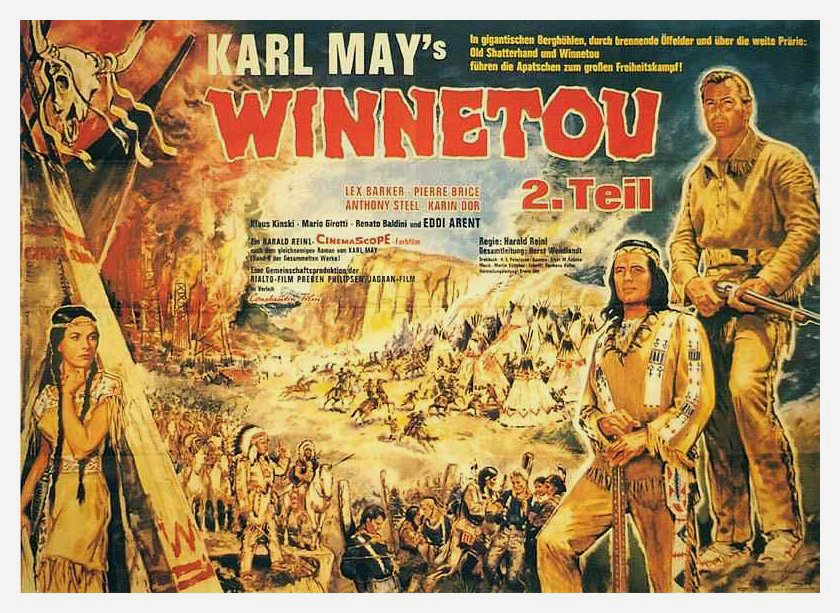
Aka - Last of the Renegades
This is the immediate follow-up to Winnetou which told the story of Apache
Chief Winnetou and Old Shatterhand becoming blood brothers. This German Western
portrays the Indians very positively while the white folks not so much. It
is directed again by Harald Reinl. who went back and forth between Westerns
and Krimis. He gives this film a wide open spectacular look. The colors are
deep and stunning - and the landscapes in what was Yugoslavia are the stuff
of Westerns - rugged and gorgeous. There is this lake that is this blue green
color that just begs for you to go in and a large cavern that is beautiful.
I go on about this because these films are worth watching just for the cinematography.
There is a rapacious gang of outlaws who want to create a war between the
whites and the Indians so that they can grab their land. Winnetou (Pierre
Brice) is attempting to keep the peace and have the Indian chiefs sign a
treaty with the army. His friend Old Shatterhand (Lex Barker) and his sidekick
Lord Castlepool of the pith helmet is working with Winnetou. One of the tribes
has captured three soldiers and are about to burn them at the stake when
Winnetou convinces the chief to let them go. The Lieutenant takes one look
at the chief's daughter Ribanna and decides he is very much in favor of improving
relations with the Indians. Problem is Winnetou loves her too and she him.
It is not resolved in a way you would expect. There are the expected fire
fights, an attack on innocent Indian villagers, a bear fight and Winnetou
and Old Shatterhand of course resolve it with a lot of killing.
It doesn't seem as good as the previous film - Winnetou - as it has a little
less variety to it but there is plenty of action and horse riding and that
is always a plus for me. It does though have a very solid cast of a few non-Europeans
working in Europe and a few Germans that Rialto Studios regularly used for
the Edgar Wallace Krimis that they made. Lex Barker had basically moved to
Europe in the late 1950's after he became dissatisfied with the films he
was getting in Hollywood. He was to make loads of films in Europe - in Germany
and Italy. As the head of the gang they got Anthony Steel who had been a
big adventure star in England in the 1950s - which was fitting as he had
been a hero in WWII and had escaped from Dunkirk. On the German side the
lovely Karin Dor plays Ribanna - yes brown face as I assume a number of the
other actors were. Good old Klaus Kinski was his usual rotten self being
the righthand man to the gang head and Eddie Arent,who is in so many of those
Edgar Wallace films as comic relief performs the same duties here. And finally
there is an Italian who plays the Lieutenant named Mario Girotti. A few years
later he Americanized his name to Terence Hill and became a huge Euro-Western
star in the Trinity films, God Forgives . . . I Don't and many others.
This film and four others as well as Winnetou and Old Firehand with Rod Cameron
are currently up on Amazon Prime. Unfortunately, I can't get Prime out of
region. Not sure if they are dubbed as this one is but I expect so.
The Sons of Great Bear (1966) - 5.0
Director: Josef Mach

As I mentioned in a review of the West German Western Winnetou, East Germany
also plunged into Westerns (Indianerfilme). While the West German ones portrayed
the Indians as noble, they also offset it with Old Shatterhand, the white
friend of the Indians. The East German Westerns make no such capitulation
- the Indians are still very noble and heroic but finding a good white man
is like finding a gold nugget in your box of Crackerjacks. They are greedy,
dishonorable and rapacious - and those are their best qualities. The East
German films had to be socially relevant - the Indians symbolized innocence
while the white men symbolized American expansionism, capitalism racism and
cruelty against minorities. Well, in truth that sounds about right. As I
have gotten older and more sensitive to the history of the Native Americans,
I really find it hard to watch the old Westerns in which Indians are portrayed
as sneaky blood thirsty savages who idiotically charge or circle against
repeat rifles. But there were sadly so many great Westerns that have aspects
of that - the John Ford films especially. So I try to keep my Western viewing
to films in which white men kill white men! But these German Westerns make
it ok to watch white men against the Indians.
As an aside that has nothing to do with this film but that I found interesting
when I read about it - is that the entire Eastern Block of Communist nations
loved Westerns. In Russia of all places they made a number of them going
back to the 1920's - as Stalin was a big fan of them - though no American
Westerns were allowed in. These were referred to as Red Westerns or Ostern.
The first American Western to be distributed was The Magnificent Seven in
1962 and it was huge at the box office. Westerns were popular all over -
the Germans ones and the American ones if they were allowed. Yugoslavia often
participated in the making of these Westerns as they were often shot there.
After the success of Winnetou and other German Westerns, the East Germans
decided to make one - that being this one. Perhaps they improve later on
but in truth this is nowhere as good as the two Winnetou's I have seen. The
scenery isn't as interesting, the cinematography doesn't have the same sense
of God's Country, the acting feels off, the East German women are nothing
to write home about (one has a very discernable moustache), the plot is ragged
but mainly the editing is quite awful. Surprisingly so. One second a guy
gets off his horse in a fight and in the next shot he is riding it again.
In one of the few action scenes it consists of men shooting and someone falling
off their horse. And the Indians are way too good. They were not that noble
I expect. East Germany could not use Karl May as their source since Hitler
had been a fan - that clearly didn't bother the other side - so in this case
their source was a trilogy by Liselotte Welskopf-Henrich about the Indian
Tokei-Ihto of the Dakotas. Unlike Karl May, Liselotte was a scholar who had
gone to the USA to study Indian culture. She also during WWII was a resister
to the Nazis and hid a Communist in her apartment, who she later married.
She chose to live in East Germany.
The plot isn't that interesting. A group of white men led by Red Fox kill
the father of Tokei-Ihto which doesn't lead to the revenge one expects. The
white gang in cahoots with the corrupt Army want the gold on the Indian land
so they connive to get them off the land into a reservation. Tokei-Ihto resists.
Obviously that plot has to filled in with a few fights and white racism but
that pretty much covers it. The film was a huge success in East Germany and
the actor who played Tokei-Ihto became a huge star. Gojko Mitic was from
Yugoslavia and was chosen to take on this role and a bit like Pierre Brice
(Winnetou), he ended up playing many Indian roles. But it made him a star
and being a star in Yugoslavia was probably a good thing.
